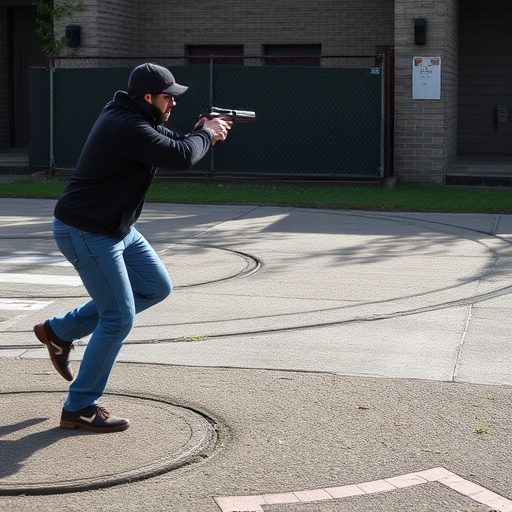Immediate emergency treatment for a pepper spray attack involves moving to safety, removing contaminated clothing, and rinsing affected areas with water for 15 minutes. For eyes, keep eyelids open while rinsing. Long-term care includes preventing wounds and infections, using pain relievers, keeping the area clean and dry, and seeking medical attention if symptoms persist or worsen.
“Aerosol spray defense has become a crucial tool in personal safety, especially during unexpected attacks. This article delves into effective strategies to navigate these high-stakes situations. We explore pepper spray’s immediate impact and offer vital guidance on emergency treatment after a pepper spray attack, detailing steps to take both during and afterward. From understanding the effects of aerosol spray to implementing long-term care and prevention techniques, this comprehensive guide equips individuals with essential knowledge for self-defense and emergency preparedness.”
- Understanding Pepper Spray and Its Effects
- Immediate Actions After Coming Under Attack
- First Aid for Pepper Spray Exposure
- Long-Term Care and Prevention Strategies
Understanding Pepper Spray and Its Effects
Pepper spray, an aerosol defense agent, is designed to incapacitate attackers temporarily by causing intense irritation and pain in the eyes and respiratory system. When deployed, it creates a cloud of oleochocine capsaicin, a chemical derived from chili peppers, which can disable an assailant for several minutes, providing an opportunity for escape or help.
Understanding how pepper spray works is crucial for those seeking to protect themselves, as well as for emergency medical personnel who must administer effective treatment after a pepper spray attack. Immediate emergency treatment involves flushing the eyes with clean water for at least 15 minutes to dilute the capsaicin and relieve irritation. If breathing is difficult, victims should move to an area with fresh air and, if necessary, seek medical attention promptly due to potential respiratory complications.
Immediate Actions After Coming Under Attack
In the immediate aftermath of a pepper spray attack, the first step is to move to a safe location away from the attacker and any potential sources of further exposure. This could be a nearby building, a car, or any enclosed space where fresh air is readily available. Removing contaminated clothing and washing affected areas with water are crucial emergency treatment steps to mitigate the effects of the spray.
Respiratory distress, eye irritation, and skin discomfort are common symptoms. Administering oxygen if available, and seeking medical attention promptly, especially for those with pre-existing conditions or children, can be vital. It’s important to remember that while these actions help in managing symptoms, professional medical care is necessary to ensure complete recovery from a pepper spray attack.
First Aid for Pepper Spray Exposure
In the event of a pepper spray attack, immediate and proper first aid is crucial for mitigating the effects of the irritant. If exposed, the first step is to move to a safe, well-ventilated area to prevent further inhalation. Remove any clothing or materials that came into contact with the spray, being careful not to rub or wipe the eyes as this can exacerbate irritation. Rinse the affected areas thoroughly with water for at least 15 minutes to dilute and flush out the pepper spray chemicals.
For eye exposure, hold the eyelids open gently and continue rinsing. Seek medical attention promptly if symptoms persist or worsen, as emergency treatment after a pepper spray attack may include additional measures such as using eye-washing stations or receiving topical treatments for skin irritation. Additionally, staying hydrated and avoiding strenuous activity until symptoms subside can aid in recovery from this potentially painful experience.
Long-Term Care and Prevention Strategies
In the event of a pepper spray attack, immediate and proper emergency treatment is crucial for effective care and long-term prevention. The first step involves removing any contaminated clothing or accessories, as these can retain the irritant, causing prolonged discomfort or even secondary infections. Rinsing the affected area with plenty of clean water for at least 15 minutes helps dilute the pepper spray residue, easing symptoms like stinging, burning, and difficulty breathing.
Long-term care should focus on wound prevention and infection control. This includes applying cold compresses to reduce swelling, using over-the-counter pain relievers for discomfort management, and monitoring for any signs of infection. It’s also important to keep the affected area clean and dry, avoiding exposure to further irritants or allergens that could exacerbate symptoms. Additionally, seeking medical attention is advised if symptoms persist or worsen, as emergency treatment can help prevent potential long-term health issues associated with pepper spray exposure.
In the event of an aerosol spray attack, knowledge of immediate actions, first aid, and long-term care strategies is crucial for effective emergency treatment. Understanding the effects of pepper spray and implementing prevention tactics can help mitigate its impact. Remember that swift action after exposure is key to minimizing discomfort and potential health risks. By arming yourself with this information, you’re better equipped to navigate and recover from such incidents, ensuring your safety and well-being in diverse scenarios.
